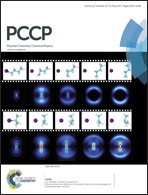DPT tautomerisation of the G·Asyn and A*·G*syn DNA mismatches: a QM/QTAIM combined atomistic investigation†
Abstract
By applying a combined QM and QTAIM atomistic computational approach we have established for the first time that the G·Asyn and A*·G*syn DNA mismatches (rare tautomers are marked with an asterisk), causing spontaneous transversions with substantially various probabilities, radically differ from each other in their ability to tautomerise through the double proton transfer (DPT). The A*·G*syn mismatch tautomerises quite easily (ΔΔGTS ≈ 4·kT at room temperature) into the A·G*syn mismatch through the asynchronous concerted mechanism, whereas the G·Asyn base mispair does not tautomerise via the DPT at all, since there is no local minimum corresponding to the tautomerised G*·A*syn mismatch on the potential energy surface. It was established that the A·G*syn base mispair is a dynamically unstable H-bonded complex with an extremely short lifetime of 2.17 × 10−13 s. Consequently, the obtained results allow us to believe that spontaneous or forced dissociation of both the G·Asyn and A*·G*syn DNA mismatches by the DNA-polymerase occurs with the preservation of the tautomeric status of the bases.


 Please wait while we load your content...
Please wait while we load your content...